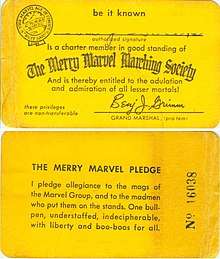Merry Marvel Marching Society
Merry Marvel Marching Society (often referred to by the abbreviation "M.M.M.S.") was a fan club for Marvel Comics started by Marvel editor Stan Lee and/or Marvel publisher Martin Goodman in 1964.
History
Following teaser promotion in Marvel comic books cover-dated November 1964, Marvel Comics introduced the company's in-house fan club, the Merry Marvel Marching Society, in its comics cover-dated February 1965, released in the fall 1964. Generally abbreviated as the "M.M.M.S", the club offered readers a $1 membership kit that initially included a

- welcoming letter
- membership card
- one-sided, 331⁄3 rpm record, "The Voices of Marvel"
- scratch pad
- sticker
- pinback button and
- certificate.[1] The company offered permutations of this kit, plus additional promotional merchandise such as posters and sweatshirts, through comics cover-dated October 1969.[2]
As author Marc Flores, who writes under the pen name Ronin Ro,[3] described,
Stan made up cards and had production people Sol Brodsky and Marie Severin help create a pin, eight stickers prominently featuring the heroes, "a nutty new notepad," a minibook, a pencil, a certificate, and a membership card. Stan wanted his bullpen[4] to join him in a special recording he'd include in the $1 membership kit. Most of the bullpen was willing, except for [Steve] Ditko.[5]
The club proved successful, with Marvel secretary and club coordinator Flo Steinberg remarking that they "were working seven days a week just opening these envelopes" containing the subscription fee.[5] In a 2002 interview, Steinberg said,
"Bags and bags of mail would come in and we would open them up, and — this was before computers — we had to write down everybody's name and make labels for each one, and pull out all these hundreds of dollar bills. We were throwing them at each other there were so many!"[6]
Soon, the club offered a range of other money-spinning products, including:[5]
- Six-foot "life-size, full-color Spidey pin-up" made from a Steve Ditko drawing of Spider-Man
- $1.50 T-shirt with a Ditko-drawn Dr. Strange
- Thing drawing by Jack Kirby on "Official Swingin' Stationery"
- Fantastic Four family portrait T-shirt by Kirby.
The M.M.M.S. membership had ranks indicated by three-letter abbreviations (such as Q.N.S. for "Quite 'Nuff Sayer" to F.F.F. for "Fearless Front-Facer"), based on a proposal by young comics fan Mark Evanier.[7]
The M.M.M.S. was absorbed into the subsequent Marvel fan club, Marvelmania International, in 1969. This second club lasted until 1971. A third official Marvel Comics fan club, FOOM (Friends of Ol' Marvel) followed from 1973 to 1976.
In popular culture
The character of Hiro Nakamura on Heroes is reported to be an M.M.M.S. member in the episode "Don't Look Back".
The M.M.M.S. is mentioned in the end-theme of the syndicated 1966 TV show The Marvel Super Heroes, which featured the lyric "You belong to the Merry Marvel Marching Society". The "Merry Marvel Marching Society" song also played during the end credits of the video game Lego Marvel Super Heroes, as well having Stan Lee humming the tune in some of his perils throughout the game.
References
- House ad, Marvel Comics issues cover-dated February 1965
- Ballman, J. The Full-Color Guide to Marvel Silver Age Collectibles from M.M.M.S. to Marvelmania, p. 80. (Totalmojo Productions, 2007) ISBN 978-0-9815349-0-9
- Ives, Nat (January 31, 2005). "MediaTalk; Who Deserves The Credit (and Cash) For Dreaming Up Those Superheroes?". The New York Times. Archived from the original on November 23, 2011.
- https://web.archive.org/web/20110122031052/http://costa.lunarpages.com/bp/bullpen.html
- Ro, Ronin (2004). Tales to Astonish: Jack Kirby, Stan Lee and the American Comic Book Revolution. Bloomsbury. p. 84.
- Cooke, John B. (March 2002). "Absolutely Fabulous: Reminiscing with America's favorite comic book sweetheart". Comic Book Artist. TwoMorrows Publishing (18): 8B–9B.
- Evanier, Mark. "How I Became a Young, Zingy, With-It Guy". NewsFromME.com. Archived from the original on January 7, 2016. Retrieved January 6, 2016.
- Pratt, Doug. "The MMMS Records Remastered", DogRat.com, September 23, 2007. The Voices of Marvel and Scream Along with Marvel. Archive.org archive, WebCitation archive.
External links
- Brady, Terrence H. (n.d.). "Merry Marvel Marching Society". Third Millennium Entertainment (fan site). Archived from the original on July 19, 2011.